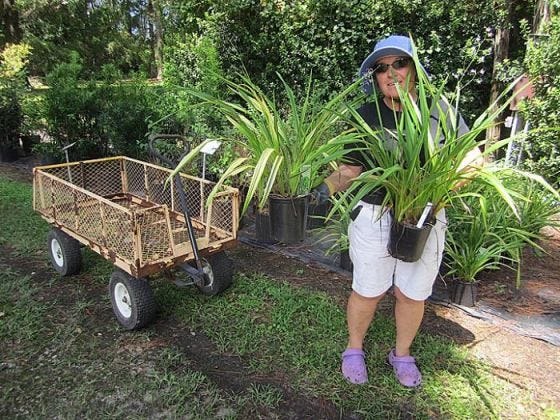
CRESTVIEW—Larry Williams, director of the University of Florida/IFAS Okaloosa County Extension, makes no bones about the best time of year for backyard green thumbs to be planting their gardens. As autumn’s cooler weather settles into Northwest Florida, it’s the best time to be planting, he said.
Speaking at the Crestview Public Library’s monthly First Tuesday lecture, Williams stressed that despite spring’s reputation throughout the rest of the country as planting season, it’s the autumnal equinox six months later that actually heralds the best local time to plant.
“I’ve been trying to convince people that fall is the best time to plant since I’ve been an extension agent, but you can’t beat the spring fever factor,” Williams told the library meeting room’s overflow audience. “Spring fever just hits. You’re driven to go outside and plant something.”
Williams stated the reasons for planting in the fall.
“When we move into October and November, it is more comfortable to be outdoors,” he said. “The survival rate goes up for those trees and shrubs planted in the fall of the year. Some of your locally owned nurseries will typically get your best selection of trees and shrubs in the fall, and those garden centers need our business this time of year.”
Lori Jansen was a step ahead of Williams. Three days before his lecture, the Crestview resident was towing a wagon laden with golden streak dianellas around Crestview Nurseries, more familiarly known to many locals as “Tommy Horn’s.”
“I’m trying to find plants for a perennial garden, one I don’t have to keep redoing,” Jansen said. “We’re redoing some gardens; kind of an erosion control thing.”
Crestview resident Dot Moxey said she was looking forward to planting her fall garden and took copious notes as Williams listed some of the numerous plants that fare best when planted in the fall.
“Oh yes, I’m getting ready to do my garden,” Moxey said. “I transplanted a couple bulbs yesterday. They might be flowers or they might be really good grass. We’ll find out soon as they come up.”
New Jersey native Phyllis Alles has lived locally more than 16 years, and has finally come to grips with the area’s sandy soil. She hung around after William’s presentation to pick his brain some more.
“I realized there’s no way I’ll ever be able to have a decent lawn,” Alles said. “I’ve learned to go with native plants. The first year I planted here, everything dried up and wilted.”
Williams advised planting monkey grass — also called border grass — if Alles’ lawn is shady. She especially liked his recommendation to go with native plants such as Asiatic jasmine, which provides a useful groundcover.
“It costs a lot of have a lawn, and people’s expectations and what it takes to get there don’t match,” Williams said. “Most people do not have the time to achieve a good lawn. It’s a want they can’t achieve.”
Williams also cautioned against “winterizing” a local lawn by spreading winter fertilizer mixes, a practice often seen farther north. The practice encourages young grass shoots to grow that are then killed off by frost.
“Do not buy into the idea of winterizing. Winterizing does not work this far south,” Williams said. “If you throw that (fertilizer) out there, you’re not doing your pocketbook a favor; you’re not doing your lawn a favor. You’re doing the brown patch (a grass-killing fungus) a favor and the guy who re-sods your lawn a favor.”
Okaloosa Master Gardeners, including past president Marg Stewart, were on hand with Williams to answer audience members’ questions. The trained gardening experts volunteer countless annual hours to help local amateur gardeners.
“The Master Gardeners helped me design my yard. They are great people,” Jansen said. “They came over to advise me on our erosion problem, and I’ve been calling on them ever since.”
Above all, just have fun with the fall growing season, and reap the benefits come spring, Williams advised.
“We worry ourselves silly about things we shouldn’t be worrying about. Fall is for fun,” he said. “It’s the best time of year. There’s so many things to enjoy in the fall than worrying about an imperfect lawn or azaleas dying.”
Fall planting time tips
University of Florida/IFAS Okaloosa County Extension director Larry Williams offered useful tips for planting during autumn, the best planting season for Northwest Florida. Local nurseries carry plants best suited for local planting, as opposed to box stores whose out-of-state buyers aren’t familiar with local conditions, he advised.
• Annuals: sow seeds in late October for bachelor buttons, calendula, candytuft, larkspur, nasturtium, poppies, sweet alyssum and sweet pea.
• Shrubs, Perennials: Plant hollies, azaleas, dogwoods, crepe myrtles, oaks and most perennials in fall to early winter.
• Vegetables: Plant from fall to early spring: beets, broccoli, Brussels sprouts (best planted as fall crop), cabbage, carrots, cauliflower, collards, garlic, kohlrabi, green onions, radishes, shallots, Swiss chard and turnips.
• Bulbing onions: Plant Excel, Texas Grano, Granex, White Granex and Tropicana Red from October to early December.
• Strawberries: Plant in October and November. Do not wait until the big box stores put out strawberry plants in the spring, Williams said. Plant Florida 90, Tioga, Sequoia, Florida Belle, Sweet Charlie, Chandler, Camarosa and Strawberry Festival.
• Herbs: Plant when it turns cool. Among herbs that do well locally are parsley, oregano, sage, thyme, rosemary and sweet marjoram; sow seeds like dill, fennel, chervil, arugula and cilantro.
This article originally appeared on Crestview News Bulletin: Autumn beats spring when it comes to local planting season
